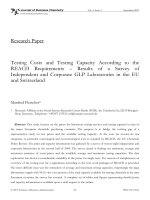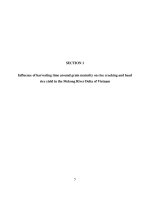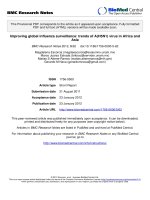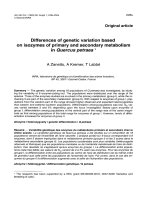Comparision of genetic variation between avian influenza type A H5N1 virus causing disease and circulating on poultry in some provinces in the Mekong Delta in 2016
Bạn đang xem bản rút gọn của tài liệu. Xem và tải ngay bản đầy đủ của tài liệu tại đây (266.45 KB, 6 trang )
<span class='text_page_counter'>(1)</span><div class='page_container' data-page=1>
<i>DOI: 10.22144/ctu.jen.2019.005 </i>
<b>Comparision of genetic variation between avian influenza type A H5N1 virus </b>
<b>causing disease and circulating on poultry in some provinces in the Mekong Delta in 2016 </b>
Tien Ngoc Tien1*<sub> and Ly Thi Lien Khai</sub>2
<i>1<sub>PhD student in Pathology and Treatment of Animals, Department of Veterinary Medicine, College of </sub></i>
<i>Agriculture, Can Tho University </i>
<i>2<sub>Department of Veterinary Medicine, College of Agriculture, Can Tho University, Vietnam </sub></i>
<i>Correspondence: Tien Ngoc Tien(email: ) </i>
<b>Article info. </b> <b> ABSTRACT </b>
<i>Received 05 Oct 2018 </i>
<i>Revised 15 Dec 2018 </i>
<i>Accepted 29 Mar 2019 </i>
<i><b> The study is aimed to determine the genetic variation of type A H5N1 avian </b></i>
<i>influenza virus in some provinces in the Mekong Delta in 2016. </i>
<i>Oro-phar-yngeal swab samples were collected on healthy chickens, ducks that were </i>
<i>sold in markets and at slaughterhouses; tissue samples were also collected </i>
<i>from poultry suspected cases of type A H5N1 avian influenza. These </i>
<i>sam-ples were tested by real time reverse transcription polymerase chain </i>
<i>reac-tion (rRT-PCR) technique to detect type A H5N1 avian influenza virus. </i>
<i>Hemagglutinin (HA) gene of some representative samples were sequenced </i>
<i>to determine the genetic variation and virus clade. There were sequenced </i>
<i>10 HA genes of avian influenza type A H5N1 virus. The results of the </i>
<i>ge-netic variation survey showed that the nucleotides homology rate between </i>
<i>avian influenza type A H5N1 strains causing disease and circulating on </i>
<i>poultry in the Mekong Delta provinces in 2016 were from 94.5% to 98.5% </i>
<i>and amino acids were from 92.5% to 99.3%, respectively. The sequence of </i>
<i>the amino acids at the linkage between the HA1 and HA2 fragment was </i>
<i>RRRKR similar to highly pathogenic avian influenza virus as </i>
<i>A/chicken/Korea/IC546/2011 and A/Hubei/1/2010 references. This </i>
<i>indi-cates that the avian influenza type A H5N1 virus isolated in this study is </i>
<i>highly pathogenic. Avian influenza type A H5N1 viruses circulating and </i>
<i>causing disease on poultry in some provinces in the Mekong Delta in 2016 </i>
<i>belong to the clade virus 2.3.2.1c. </i>
<i><b>Keywords </b></i>
<i>Avian influenza, Chicken, </i>
<i>Duck, Type A H5N1 </i>
Cited as: Tien, T.N. and Khai, L.T.L., 2019. Comparision of genetic variation between avian influenza type
A H5N1 virus causing disease and circulating on poultry in some provinces in the Mekong Delta
<i>in 2016. Can Tho University Journal of Science. 11(1): 36-41. </i>
<b>1 INTRODUCTION </b>
Avian influenza is an acute infectious disease of
several avian species, caused by the influenza A
rus of the Orthomyxoviridae family. Influenza
vi-ruses are classified into two groups as highly
pathogenic avian influenza and low pathogenic
avian influenza. This classification is based on the
pathogenicity of the avian influenza virus (OIE
Ter-restrial Manual, 2015). In the recent years from
</div>
<span class='text_page_counter'>(2)</span><div class='page_container' data-page=2>
H5N1 avian influenza virus in some provinces in the
Mekong Delta in 2015 was 6.5%. Therefore, it can
be shown that these areas have just been circulating
the virus, and the disease outbreak occurred at the
same time. This study was conducted to determine
the genetic variation between type A H5N1 avian
influenza viruses causing diseases and circulating
on poultry in some provinces in the Mekong Delta.
<b>2 MATERIALS AND METHODS </b>
<b>2.1 Materials </b>
The study was conducted in An Giang, Ca Mau,
Dong Thap, Can Tho, Soc Trang and Tra Vinh
prov-inces from January 2016 to December 2016.
Re-search subjects were healthy chickens and ducks
sold in markets or in slaughterhouses; poultry have
suspected clinical signs, lesions of type A H5N1
avian influenza.
<b>2.2 Sampling method </b>
Oro-pharyngeal swab samples were collected from
healthy chickens and ducks that sold in markets and
at slaughterhouses. Individual sample from 5 birds
was pooled into one testing sample (OIE Terrestrial
Manual, 2015). A total of 120 samples from ducks
and 120 samples from chicken were collected in An
Giang, Ca Mau, Dong Thap, Can Tho city (30 duck
samples and 30 chicken samples per each province
or city).
A total of 23 specimens (brain, spleen, treachea and
lung) of poultry with typical symptoms of suspected
cases of type A H5N1 avian influenza were
col-lected (01 sample from Ca Mau, 10 from Can Tho,
11 from Soc Trang and 01 from Tra Vinh).
<b>2.3 Testing method </b>
All swab and tissue samples (brain, spleen, trachea
and lungs) were taken to laboratories and tested by
real time reverse transcription polymerase chain
re-action (rRT-PCR) technique to identify type A
H5N1 avian influenza virus. When samples positive
for type A H5N1 avian influenza viruses were
iden-tified, the HA gene was sequenced to compare
ge-netic variation by using the Molecular Evolutionary
<i>Genetics Analysis (MEGA 6.0; Tamura et al., </i>
2013).
<b>2.4 Sequencing and analysis of the HA gene </b>
<b>sequence to compare the genetic variation of </b>
<b>type A H5N1 avian influenza virus method </b>
Hemaglutinin (HA) of type A H5N1 virus was
se-quenced with two pairs of specific primers which
were amplified by transcription polymerase chain
reaction (RT-PCR). The first primer amplifies the
1,100 bp and the second primer amplifies the HA2
gene amplification size of 1,000 bp. The primer
pairs were used in the study following the guidelines
of the Centers for Disease Control and Prevention
(CDC). Primers used in RT-PCR include:
Primers used in RT-PCR to obtain the HA1
gene fragment were:
Forward primer: 5
'AGCAAAAGCAGGGGTY-TAAT 3',
Reverse primer: 5
'CCATACCAACCATCTAY-CATTCC 3'.
Primers used in RT-PCR to obtain the HA2 gene
fragment were:
Forward primer:
5'AYGCMTAYAAR-ATTGTCAAG 3 '
Reverse primer: 5
'AG-TAGAAACAAGGGTGTTTTTAAC TACAAT 3'.
Reagent composition of the master mix (Invitrogen
Superscript III Platinum One step qRT-PCR Kit -
US) as follows:
The volume of each reaction was 25 μl including
water without enzyme destroying RNA and DNA:
18.75 μl; buffer solution (2x): 3 μl; forward and
re-verse primer (20μM): 2 μl; enzyme: 0.25 μl. The
cy-cles were as follows: 1 cycle (50o<sub>C for 30 minutes, </sub>
94o<sub>C for 3 minutes) then 35 cycles (94</sub>o<sub>C for 15 </sub>
sec-onds, 60o<sub>C for 45 seconds) and final cycle for 72</sub>o<sub>C </sub>
for 8 minutes (SuperScript ™ III Platinum ™
One-Step qRT-PCR Kit Product Information Sheet).
Amplification product measured by electrophoresis
method on 2% agar. The amplification of the HA1
<i>and HA2 genes were 1,100 and 1,000 bp. </i>
Selected samples have HA1 and HA2 gene
ampli-fiers of the right size (1,100bp and 1,000bp)
accor-ding to the gene sequencing design and senaccor-ding to
gene sequence at the Macrogen Company in Korea.
<i><b>2.5 Analysis of HA gene sequences method </b></i>
The HA sequences of the H5N1 avian influenza A
virus were processed and analyzed by MEGA 6.0
<i>(Tamura et al., 2013) to determine the nucleotide </i>
differentiation rate then to calculate the homology
rate among the virus strains. Identification of the
type A H5N1 avian influenza virus clade was
per-formed by using the Neighbor-Joining method with
1,000 replicates of the bootstrap credibility.
<b>3 RESULTS AND DISCUSSIONS </b>
</div>
<span class='text_page_counter'>(3)</span><div class='page_container' data-page=3>
<b>influenza virus circulating and causing disease </b>
<b>on poultry </b>
<i>The 10 HA gene of type A H5N1 avian influenza </i>
virus was sequenced with the length from 1.640 to
1.695 nucleotides; result in a comparison of
nucleo-tide and amino acid variants of virus isolates in the
study was presented in Table 1 and Table 2.
The comparative results of nucleotides showed that
there has been differentiation between type A H5N1
avian influenza viruses that cause disease and
circu-lating in poultry in some provinces in the Mekong
Delta in 2016. The virus strains A/Duck/TV/1605/
2016 causing disease on duck in Tra Vinh had a high
homology rate with A/Muscovy duck/CM/1834/
2016 circulating on Muscovy ducks in Ca Mau
which differentiated rate was 1.5%. Meanwhile, the
virus strain A/Chick/ST/1607/2016 causing disease
on chicken in Soc Trang had the highest incidence
(5.5%) compared to the A/Chick/AG/0010/2016
strains circulating on chicken in An Giang. In
general, the differentiation in nucleotide levels
among type A H5N1 avian influenza virus strains
that causes disease and circulating in poultry in the
Mekong Delta provinces in 2016 was 1.5% to 5.5%.
In other words, the rate of homology between type
A H5N1 avian influenza strains causing disease and
circulating in poultry in the Mekong Delta in 2016
was 94.5% to 98.5%. These homological rates were
higher than the research of Duong Thi Thanh Thao
and Ly Thi Lien Khai (2011) with the rate of
homology between the virus strains isolated in Soc
Trang and Ca Mau being 92-98%.
<b>Table 1: Number of different nucleotide positions between type A H5N1 avian influenza virus causing </b>
<b>disease and circulating in poultry in the Mekong Delta’s provinces in 2016 </b>
<b>Type A H5N1 </b>
<b>Influenza virus causing </b>
<b>disease on poultry </b>
<b>Number and percentage of nucleotides varying of avian influenza A H5N1 </b>
<b>strains causing disease and circulating on poultry </b>
<b>Type AH5N1 influenza virus circulates on poultry </b>
<b>A/Chick/AG/ </b>
<b>0010/2016 A/Duck/CM/0057/2016 A/Duck/DT/ 1760/2016 A/Duck/DT/ 1767/2016 vyduck/CM/1834/2016 </b>
A/Musco-A/Duck/TV/1605/2016 63 (3.8%) 30 (1.8%) 39 (2.4%) 64 (3.9%) 26 (1.5%)
A/Duck/CT/1606/2016 70 (4.3%) 27 (1.6%) 38 (2.3%) 64 (3.9%) 26 (1.5%)
A/Chick/ST/1607/2016 90 (5.5%) 38 (2.3%) 29 (1.7%) 60 (3.6%) 31 (1.9%)
A/Chick/CT/1613/2016 70 (4.3%) 27 (1.6%) 38 (2.3%) 64 (3.9%) 26 (1.5%)
A/Chick/CM/1635/2016 75 (4.6%) 33 (2.0%) 44 (2.7%) 69 (4.2%) 34 (2.1%)
<b>Table 2: Number of different amino acid positions of type A H5N1 avian influenza virus that causing </b>
<b>disease and circulating in poultry in the Mekong Delta in 2016 </b>
<b>Type A H5N1 </b>
<b>Influenza virus causing </b>
<b>disease on poultry </b>
<i><b>Number and percentage of amino acids varying in type A H5N1 avian influenza </b></i>
<b>strains causing disease and circulating on poultry </b>
<b>Type AH5N1 influenza virus circulates on poultry </b>
<b>A/Chick/AG/</b>
<b>0010/2016 </b> <b>A/Duck/CM/0057/2016 </b> <b>A/Duck/DT/ 1760/2016 </b> <b>A/Duck/DT/ 1767/2016 </b> <b>vyduck/CM/1834/2016 </b>
A/Musco-A/Duck/TV/1605/2016 36 (6.6%) 9 (1.6%) 4 (0.7%) 15 (2.7%) 5 (0.9%)
A/Duck/CT/1606/2016 39 (7.1%) 8 (1.5%) 5 (0.9%) 16 (2.9%) 8 (1.5%)
A/Chick/ST/1607/2016 41 (7.5%) <i> 11 (2.0%) </i> 4 (0.7%) 16 (2.9%) 9 (1.6%)
A/Chick/CT/1613/2016 40 (7.3%) 9 (1.6%) 6 (1.1%) 17 (3.1%) 9 (1.6%)
A/Chick/CM/1635/2016 41 (7.5%) 11 (2.0%) 8 (1.5%) 18 (3.3%) <i> 10 (1.8%) </i>
The different amino acids among type A H5N1
avian influenza strains causing disease and
circulat-ing in poultry in some provinces in the Mekong
Delta in 2016 ranged from 0.7% to 7.5% which had
a larger gap compared to nucleotide differences
lev-els with the different rates from 1.5% to 5.5%. The
strain of A/Duck/DT/1760/2016 circulating on duck
in Dong Thap had the lowest differentiated rate
(0.7%) compared to A/Duck/TV/1605/2016 strain
causing disease on ducks in Tra Vinh and
</div>
<span class='text_page_counter'>(4)</span><div class='page_container' data-page=4>
<b>Table 3: The amino acid sequence where linkage between HA1 and HA2 (cleavage site) of type A </b>
<b>H5N1avian influenza that causing disease and circulating in poultry in some provinces in the </b>
<b>Mekong Delta in 2016 </b>
<b>Virus strains code </b> <b>The amino acid sequence between HA1 and HA2 <sub>(cleavage site) </sub></b>
A/Duck/TV/1605/2016 R R R K R
A/Duck/CT/1606/2016 R R R K R
A/Chick/ST/1607/2016 R R R K R
A/Chick/CT/1613/2016 R R R K R
A/Chick/CM/1635/2016 R R R K R
A/Chick/AG/0010/2016 R R R K R
A/Duck/CM/0057/2016 R R R K R
A/Duck/DT/1760/2016 R R R K R
A/Duck/DT/1767/2016 R R R K R
A/Muscovy_duck/CM/1834/2016 R R R K R
The result showed that the amino acid sequences
be-tween HA1 and HA2 (cleavage site) of type A
H5N1 avian influenza strains causing disease and
circulating in poultry in some provinces in the
Mekong Delta in 2016 were similar (RRRKR),
which were similar to the highly pathogenic type A
H5N1 avian influenza strain 2.3.2 in the world
( and similar
to the results of the study on characteristic analysis
of HA (H5) gene and NA (N1) gene of type A H5N1
avian influenza clade 2.3.2.1 strains collected in
<i>Vi-etnam in 2014 (Le Thanh Hoa et al., 2015). Thus, </i>
the result of the amino acid sequence between HA1
and HA2 was RRRKR. It can be confirmed that
strains of type A H5N1 avian influenza viruses that
causing disease and circulating in poultry in the
Me-kong Delta provinces in 2016 were a highly
patho-genic strain.
<b>3.2 Results of clade identification of type A </b>
<b>H5N1 avian influenza causing disease and </b>
<b>circulating on poultry in some provinces in the </b>
<b>Mekong Delta in 2016 </b>
For clade identification of type A H5N1 avian
influ-enza virus, MEGA 6.0 software was used to analyze
and construct phylogenetic tree. Beside the viral
strains sequenced in this study, the sequences of the
reference strains include A/Hubei/1/2010/H5N1
(clade 2.3.2.1a; CY098758), A/barn Swallow/Hong
Kong/1161/2010/H5N1 (clade 2.3.2.1b;
KC357320), A/Vietnam/1203/2004 (clade 1;
HM006759), A/Goose/Guangdong/1/1996 (clade 0;
AF144305), A/chicken/Korea/IC546/2011 (clade
2.3.2.1c; JN807978),
A/Chicken/Vietnam/NCVD-44/2007/H5N1 (CY030531),
A/Chicken/Vi-etnam/NCVD-A937/2011/H5N1 (Clade 1.1.2;
KP097925),
A/Chicken/Vietnam/NCVD-swab15/2008/H5N1 (Clade 7.2; FJ842477),
A/Duck/Cambodia/PV027D1/2010/H5N1 (Clade
1.1.2; JN588821), A/Hong Kong/6841/2010/H5N1
(clade 2.3.2.1c; HQ636461) were used to construct
phylogenetic tree that identified the clade virus. The
results were shown in Figure 1.
Analysis of the HA gene sequences and construction
<i>phylogenetic tree plotting of type A H5N1 avian </i>
in-fluenza virus strains using MEGA 6.0 software
<i>(Tamura et al., 2013) identified all sequenced virus </i>
strains belonging to clade virus 2.3.2.1c.
</div>
<span class='text_page_counter'>(5)</span><div class='page_container' data-page=5>
<b>Fig. 1: phylogenetic tree of type A H5N1 avian influenza viruses </b>
<i>(The phylogenetic tree was built using the MEGA 6.0 software (Tamura et al., 2013) with the Neighbor-Joining method </i>
<i>and the 1,000 repeats in Bootstap reliability coefficient. Nomenclature of virus subtypes based on WHO/OIE/FAO </i>
<i>crite-ria (2014). The strains of this study were marked by black circles and squares; viruses that were marked with a black </i>
<i>circle were the virus that causing disease in poultry; viruses marked with black squares were viruses circulating in </i>
<i>birds) </i>
<b>4 CONCLUSIONS </b>
Type A H5N1 avian influenza viruses circulating
and causing disease on poultry in some provinces in
the Mekong Delta in 2016 had homological rate in
nucleotides from 94.5% to 98.5% and in amino
<i>ac-ids from 92.5% to 99.3%. The sequence of amino </i>
acids at the linkage between the HA1 and HA2
vir-ulent segments was RRRKR similar to the highly
pathogenic type A H5N1 avian influenza as
A/H5N1/IC546/2011 (H5N1) and A/Hubei/2010
(H5N1). Type A H5N1 influenza viruses isolated in
this study are highly pathogenic strains. Types A
H5N1 influenza viruses circulating and causing
dis-ease on poultry in some Mekong Delta provinces
be-long to clade virus 2.3.2.1c.
<b>REFERENCES </b>
Duong Thi Thanh Thao and Ly Thi Lien Khai, 2011.
Circulation survey and gene sequencing of avian
in-fluenza virus subtypes H5N1 in Ca Mau and Soc
Trang. Can Tho University Journal of Science, 20a:
7-17 (in Vietnamese).
Le Thanh Hoa, Nguyen Thi Bich Nga, Do Thi Roan,
Doan Thi Thanh Huong, 2015. Analysis of HA (H5)
and NA (N1) antigen traits of influenza A / H5N1
clade virus 2.3.2.1 collected in 2014 in Vietnam.
Na-tional Veterinary livestock Science Conference 2015.
Agricultural Publishing House, pp. 473-479 (in
Viet-namese).
Tamura, K., Stecher, G., Peterson, D., Filipski, A., and
Kumar, S., 2013. MEGA6: molecular evolutionary
genetics analysis version 6.0. Molecular Biology and
Evolution, 30 (12): 2725-2729.
2.3.2.1 a
2.3.2.1b
0
1
2.3.4
2.3.2.1 c
</div>
<span class='text_page_counter'>(6)</span><div class='page_container' data-page=6>
Tien Ngoc Tien, Quach Thuy Lan, Nguyen Khoa and Ly
Thi Lien Khai, 2016. Circulation and genetic
varia-tion of avian influenza virus type A H5N1 in poultry
in some provinces in the Mekong Delta. Journal of
Science, Can Tho University. Special Issue:
Agricul-ture (Volume 2): 142-151 (in Vietnamese).
World Health Organization/World Organisation for Animal
Health/Food and Agriculture Organization
(WHO/OIE/FAO) H5N1 Evolution Working Group,
2014. Revised and updated nomenclature for highly
pathogenic avian influenza A (H5N1) viruses. Influenza
and Other Respiratory Viruses 8(3): 384–388.
</div>
<!--links-->









